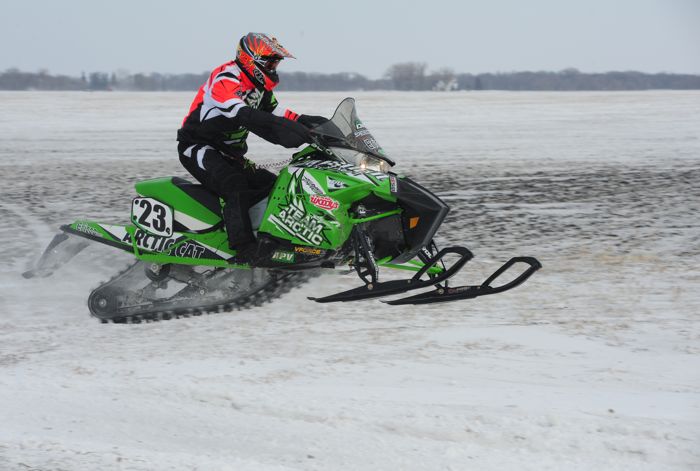
Cut from the same cloth as Kirk Hibbert, Larry Coltom, Roger Skime and many others, Arctic Cat’s Brian Dick blends equal parts “racer” and “engineer” in his role as High Performance Product Team Leader.
In Part I of the interview, he discusses the tough moments in his 2013 race season; what he and Arctic Cat have learned via racing; and his effort to bring more R&D effort into the upcoming race season.
Here, in the remainder of the interview, Brian talks about his job; which 2014 Arctic Cat he’d choose; and Roger Skime.
AI: How are you at incorporating racing into your job, and vice versa?
Dick: The value of racing comes from comparing your machines to the competition and from pushing a machine to an edge that you would never be able to replicate without it. Whenever I’m on the racetrack, I’m learning and developing. What I learn there, I bring back to the office. I know this connection makes our sleds better.
It’s the same thing that Kirk Hibbert did, the same thing that Roger Skime, Larry Coltom and dozens of other Arctic Cat racer-engineers have done.
It’s an especially exciting time right now at Arctic Cat in terms of engineers who are engaged with racing. A lot of young people here are passionate about racing and developing their performance edge. Some, like Blake Schoh (an engineer who is racing a ZR7000 in USXC this season) will be competing. Joe Wood, an ATV engineer, will race a ZR6000 RR in USXC. Others will be at the races watching and helping.
When all these people are at the races, the pool of knowledge grows to improve what we build and sell.
AI: Okay, a couple what-if scenarios for you: You’re riding for a weekend on the trails around Grand Rapids, Minn., area (Dick’s hometown), which are characterized by big woods and lots of corners. You’re with a group guys who ride hard. Which 2014 Arctic Cat sled do you pick?
Dick: Hmmm, probably the ZR7000 Sno Pro. Because it’s a fantastic trail machine that’s smooth, with awesome mileage and plenty of power.
Brian Dick pounds a NW Minnesota ditchline on a pre-production 2014 Arctic Cat ZR6000 in March of 2013.
AI: Next… you’re going to chase Roger Skime around NW Minnesota ditches for a day… which sled do you pick?
Dick: The ZR6000 RR, because it’s a great sled for chasing Roger and it’s so similar to my race sled. The RR feels so light on the front because of the way it’s sprung. It’s awesome for ditch running.
AI: Okay, last one. You’re going to buy a sled that will be your sole machine for the next three years… which one?
Dick: I’d probably buy an XF8000 141-in. because it’s a boondocking sled, which I like to do, but I could still ride on the trails. I could also take it out west to ride with my family, where it will be solid. And I could strap some stuff on the back for adventures.
AI: I’m a little surprised you didn’t opt for an XF 137-in. machine for any of those scenarios. How do you characterize the ride quality and handling differences between the ZR line with 129-in. tracks and the XF line with 137-in. tracks?
Dick: Yeah, the reality is that we have so many good options for whatever condition people ride.
A 129-in. track gives you a little better cornering and possibly a little better top speed. The 137-in. will handle trail chop and bumps a little better.
I think both are very comparable if you’re running ditches. The 129 might feel a little more fun because it’s shorter and more nimble, but the 137 is better at boon-docking and deep snow performance.
I really like the XF 137-in. with C-TEC4 four-stroke motor package. If I were buying 4-stroke, I’d buy definitely get a 137-in. The added track length helps balance the sled
Brian (R) and Roger Skime share a laugh at Skime’s ranch during a break from riding sleds in March 2013.
AI: Okay, last request: Tell me a Roger Skime story from the past few months.
Dick: I’ll tell you two things about Roger. The first is a story from last spring, when we were testing in Alaska. It was late May and we were doing some durability validation on 2014 models. Our goal was to log at least 500 miles on each machine, each day.
There’s Roger, at 68 years old, from 6 a.m. to Midnight each day, putting in his shifts on the machines ripping around the lake, which is pretty amazing in itself. While we’re there he was writing notes in his logbook, like he always does, when he says to me he has ridden 7,200 miles that season. He’s incredible!
The second story I’ll tell you about Roger is that literally, as I was calling you for this interview, Roger poked his head into my office and announced that he was back here full time, after taking a few months off. The first thing he says to me is, “I’m back, what do you want me to do?”
If I told him I needed someone to stud a track, he’d run down to the shop and do it without batting an eye. If I told him I needed to test the acceleration of a sled on grass, he’d be out there in the rain, wind and cold until he knew everything about that sled.
For Roger, there is no job too big or too small. He simply wants to do his best and make our machines better.
